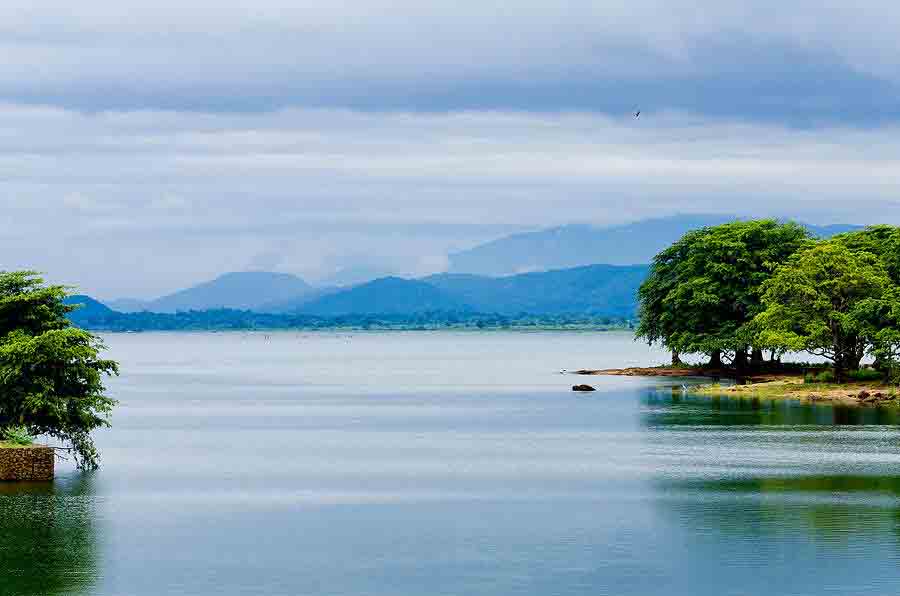UDAWALAWE NATIONAL PARK is located approximately 200 km south-east of Colombo city and is a major eco tourism destination in Sri Lanka . The 30,821 hectares dry zone game park has an annual rainfall of 1524 mm and an average temperature of 29.4°C.
It is most famous for the many elephants that live there (about 400 in total). During a visit, it is not unusual to see whole herds of adults and young elephants- feeding or bathing and playing in the water! In addition to this main attraction, the park is home to many water buffalo, water monitor lizards, sambar deer, monkeys and the occasional leopard, as well as being an exciting location for bird enthusiasts.
Udawalawe is undoubtedly the best place in Sri Lanka to see wild Asian Elephants throughout the year: there are about 500 elephants in the park and they often roam in herds of up to 100. Udawalawe National Park is unique in terms of consistency in numbers of elephants roaming the park: it has no a seasonal variation in herds of elephants. The best hours to visit the park are in the mornings and evenings. Late evening also affords the photographic opportunities in the backdrop of loveliest sunsets.
This park is very famous for the Elephants (Elephas maximus). There are herds of elephant feeding in the grasslands. The Sambar deer (Carvus unicolor), Spotted deer (Carvus axis), Muntjac (Muntiacus muntjak), wild boar (Sus scrofa) and water buffalo (Bubalus bubalis) are re-establishing themselves. Other mammals include: toque macaque (Maccaca sinica) endemic, common langur (Presbytis entellus), jackal (Canis aureus), toddy cat (Paradoxurus hermaphroditis), leopard ( Panthera pardus) and black- napped hare (Lepus nigricollis) and small Indian civet cat (Viverricula indica), endemic golden palm civet cat ( Paradoxurus zeylonensis) , three species of mongoose (Herpestes fuscus), (H. smithi) and (H. vitticollis), an endemic shrew (Suncus sp.), gerbil (Tatera sp.), rat (Rattus rattus kandianus , soft- furred rat (Millardia meltada), Indian bush rat (Golunda elliotti), mouse (Mus cervicolor) and the endemic (Mus fernandoni)
The avifauna includes large numbers of warblers ( Prinia spp .), together with the usual lowcountry birds in forested areas, and a veriety of reptors. Water birds foun on the reservoir include rare visitors such as Indian cormorant ( Phalacrocorax fuscicollis ) and osprey ( Pandion haliaetus ). Notable endemic species are Sri Lanka spurfowl ( Galloperdix bicalcarata ), Sri Lanka junglefowl ( Gallus lafayetti) , Malabar pied hornbill ( Anthracoceros coronatus) , endemic gray horonbill ( Tockus griseus ) and brown- capped babbler ( Pellorneum fuscocapillum ).
Udawalawe National Park – tourist info for Book Safari in Udawalawe ; is an excellent destination to see elephants, with herds of 50 to 60 individuals regularly seen and game drives are in open-top jeeps and accompanied by local wildlife guides.
The Sri Lankan elephant, a distinct sub-species of the mainland Asian elephant of India and Thailand, is the easiest to see. Its gentle demeanor and indomitable size has made this gentle giant a much-loved wildlife icon the world over.
Although as many as 10,000 elephant roamed Sri Lanka at the turn of the century, only some 5,000 live in the wild today. This is largely to the ‘Human Elephant Conflict’ (HEC) that leads to the death of 150-200 elephants each year, causing its classification as an endangered species.
Besides elephant, other mammal species in the park include, sambar, chital and wild boar. Dry zone birdlife includes greyheaded fish eagle, black-shouldered kite, changeable hawk eagle, crested serpent eagle, white-bellied sea eagle, shikra, common kestrel, brown fish owl and western marsh harrier.
